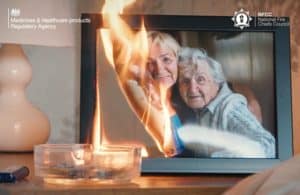A new campaign to raise awareness of the fire risk and the precautions that need to be taken by users of skin creams has been launched today
Some skin creams, when dried on to fabric, can create a highly flammable combination that can cause serious injury and death, regulators warn today. This follows research showing that the risk arises, even if the creams do not contain paraffin.
The Medicines and Healthcare products Regulatory Agency (MHRA) has partnered with the National Fire Chiefs Council (NFCC), Fire and Rescue Services and health charities in a new campaign to raise awareness of the fire risk and the precautions that need to be taken by users of skin creams.
Emollient skin creams are used by thousands of people every day to manage dry, itchy or scaly skin conditions such as eczema, psoriasis and ichthyosis. They are easily transferred from skin on to clothing and bedding. When fabric with dried-on cream comes into contact with a naked flame, the resulting fire burns quickly and intensely and can result in serious injury or death.
The risk increases with every application of the cream as it transfers, dries and builds up on the fabric. Some cream remains even when the items are washed, so it’s important to minimise the risk in additional ways, such as removing long sleeved or loose clothing before cooking or using a safety lighter.
These creams are vital in helping to manage dry skin conditions. The creams alone are not flammable, nor are they flammable when on the body. Healthcare professionals should continue to recommend them for chronic dry skin conditions and those using them should continue to do so as directed while remaining alert to the risk of fire when dried on to fabric.
MHRA first took regulatory action on the issue in 2008, and since 2018 has recommended that labelling and product information for emollient products should include a warning about the fire hazard, with clear advice not to smoke or go near naked flames.
Since 2010, more than 50 deaths and serious injuries have been linked to the use of emollient skin creams. A review has shown that those most at risk tend to be over 60, smokers and have reduced mobility. The MHRA recommends anyone in this high-risk group, or their carers, should arrange a fire service assessment of their personal surroundings. They must exercise caution when close to naked flames or potential ignition sources (for example, lighting a cigarette).
Sarah Branch, Director of MHRA’s Vigilance and Risk Management of Medicines Division said:
We want to ensure that those who are at greatest risk, and their carers, understand the fire risk associated with the build-up of residue on clothing and bedding and take action to minimise the risk. Anyone who uses emollients and has any questions or concerns should speak to a healthcare professional, such as your pharmacist or GP. Patient safety is our highest priority. We strongly encourage anyone to report any issues with such products, or more generally with any medical device, to our Yellow Card Scheme.
Rick Hylton, NFCC’s Home Safety Committee Lead said:
We now know that all emollients, combined with factors such as smoking or mobility issues, pose potential fire risks and this applies to both paraffin and paraffin-free products. Washing fabrics does not fully remove this risk. This doesn’t mean people shouldn’t use these products but we urge people to follow the updated fire safety advice. If you use these products and smoke, don’t do so when wearing clothes or bandages that may have dried on emollients. Don’t smoke in bed as bedding may have residue on it and be careful around other heat sources such as gas, halogen or open fires and when cooking.





